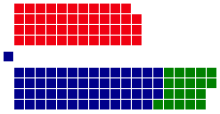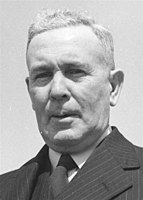1949 Australian federal election
| |||||||||||||||||||||||||||||||||||||||||||
All 123[a]seats of theHouse of Representatives 61 seats were needed for a majority in the House 42 (of the 60) seats of theSenate | |||||||||||||||||||||||||||||||||||||||||||
|---|---|---|---|---|---|---|---|---|---|---|---|---|---|---|---|---|---|---|---|---|---|---|---|---|---|---|---|---|---|---|---|---|---|---|---|---|---|---|---|---|---|---|---|
| Opinion polls | |||||||||||||||||||||||||||||||||||||||||||
| Registered | 4,895,227 | ||||||||||||||||||||||||||||||||||||||||||
| Turnout | 4,697,800 (95.97%) ( | ||||||||||||||||||||||||||||||||||||||||||
| |||||||||||||||||||||||||||||||||||||||||||
 Results by division for the House of Representatives, shaded by winning party's margin of victory. | |||||||||||||||||||||||||||||||||||||||||||
| |||||||||||||||||||||||||||||||||||||||||||
The 1949 Australian federal elections was held on Saturday December 10, All 121 seats in theHouse of Representativesand 42 of the 60 seats in theSenatewere up for election. The incumbentLabor Party,led by Prime MinisterBen Chifley,was defeated by the oppositionLiberal–Country coalitionunderRobert Menziesin alandslide.Menzies became prime minister for a second time, his first period having ended in 1941. This election marked the end of the 8-year Curtin-Chifley Labor government that had been in power since 1941 and started the 23-year Liberal/Country Coalition government. This was the first time the Liberal party won government at the federal level.
The number of MPs in both houses had been increased at the election, andsingle transferable voteunder aproportional votingsystem had been introduced in the Senate. Though Labor lost government, Labor retained a Senate majority at the election. However, this ended at the1951 election.With the Senate changes in place, Labor has not held a Senate majority since.
Future Prime MinistersWilliam McMahonandJohn Gortonboth entered parliament at this election.
Issues
[edit]The election hinged on the policies of the Federal Labor government, especially banknationalisation.Prime Minister Chifley intended to bring all of the banks under Government control, a socialist policy which the Coalition argued was not in the country's interest. The Coalition promised to end unpopularwartime rationing.The election took place against the background of the1949 Australian coal strike,the developingCold Warand growing fears of communism.
Robert Menzies broke new ground in using the radio as his primary method of reaching voters.[1]
Electoral reform
[edit]As of this election,single transferable votewithproportional representationbecame the method for electing the Senate. This was to try to prevent the Senate from being dominated by one party, which had often occurred previously. For example, coming into this election the ALP held 33 of the 36 Senate seats, whilst theNationalist Partyat the1919 electionheld 35 of the 36 Senate seats. In addition, theHouse of Representativeswas enlarged from 74 to 121 seats and theSenatefrom 36 to 60 members. All 121 lower house seats, and 42 of the 60 upper house seats, were up for election.
Opinion polling
[edit]| Primary vote[b] | ||
|---|---|---|
|
Results
[edit]House of Representatives
[edit]
| Party | Votes | % | Swing | Seats | Change | ||
|---|---|---|---|---|---|---|---|
| Liberal–Country coalition | 2,314,143 | 50.26 | +6.61 | 74 | +45 | ||
| Liberal | 1,813,794 | 39.39 | +6.44 | 55 | +37 | ||
| Country | 500,349 | 10.87 | +0.17 | 19 | +8 | ||
| Labor | 2,117,088 | 45.98 | –3.73 | 48[c] | +4 | ||
| Communist | 40,941 | 0.89 | –0.60 | 0 | 0 | ||
| Labor (Non-Communist) | 32,870 | 0.71 | –0.88 | 0 | –1 | ||
| Independents | 99,368 | 2.16 | +0.34 | 1[d] | –1 | ||
| Total | 4,604,410 | 123 | +48 | ||||
| Two-party-preferred(estimated) | |||||||
| Liberal–Country coalition | Win | 51.00 | +5.10 | 74 | +45 | ||
| Labor | 49.00 | −5.10 | 47 | +4 | |||
Senate
[edit]| Party | Votes | % | Swing | Seats won | Seats held | Change | ||
|---|---|---|---|---|---|---|---|---|
| Liberal–Country coalition | 2,113,447 | 50.41 | +7.08 | 23 | 26 | +23 | ||
| Liberal–Country joint ticket | 1,871,849 | 44.65 | +6.53 | 16 | N/A | N/A | ||
| Liberal | 241,598 | 5.76 | +0.55 | 7 | 21 | +19 | ||
| Country | N/A | N/A | N/A | 0 | 5 | +4 | ||
| Labor | 1,881,956 | 44.89 | –7.17 | 19 | 34 | +1 | ||
| Communist | 87,958 | 2.10 | +2.10 | 0 | 0 | 0 | ||
| Protestant People's | 37,441 | 0.89 | –2.13 | 0 | 0 | 0 | ||
| Independents / ungrouped | 71,723 | 1.71 | +1.03 | 0 | 0 | 0 | ||
| Total | 4,192,525 | 42 | 60 | +24 | ||||
Seats changing hands
[edit]| Seat | Pre-1949 | Swing | Post-1949 | ||||||
|---|---|---|---|---|---|---|---|---|---|
| Party | Member | Margin | Margin | Member | Party | ||||
| Australian Capital Territory, ACT | new division | 3.8 | Lewis Nott | Independent | |||||
| Ballaarat, Vic | Labor | Reg Pollard | 3.1 | 3.1 | 0.4 | Alan Pittard | Liberal | ||
| Bass, Tas | Labor | Claude Barnard | 7.0 | 6.8 | 0.6 | Bruce Kekwick | Liberal | ||
| Blaxland, NSW | Lang Labor | notional - new seat | N/A | 53.4 | 3.4 | Jim Harrison | Labor | ||
| Bowman, Qld | Labor | notional - new seat | N/A | 1.4 | 3.8 | Malcolm McColm | Liberal | ||
| Corio, Vic | Labor | John Dedman | 7.2 | 6.7 | 0.3 | Hubert Opperman | Liberal | ||
| Curtin, WA | Labor | notional - new seat | N/A | 13.8 | 11.2 | Paul Hasluck | Liberal | ||
| Darling Downs, Qld | Country | Arthur Fadden | N/A | 1.9 | 12.5 | Reginald Swartz | Liberal | ||
| Dawson, Qld | Labor | notional - new seat | N/A | 9.8 | 8.6 | Charles Davidson | Country | ||
| Denison, Tas | Labor | Frank Gaha | 7.0 | 10.9 | 5.1 | Athol Townley | Liberal | ||
| Farrer, NSW | Country | notional - new seat | N/A | 58.8 | 8.8 | David Fairbairn | Liberal | ||
| Forrest, WA | Labor | Nelson Lemmon | 2.3 | 4.4 | 2.8 | Gordon Freeth | Liberal | ||
| Gwydir, NSW | Labor | William Scully | 1.2 | 9.2 | 5.1 | Thomas Treloar | Country | ||
| Hume, NSW | Labor | Arthur Fuller | 4.2 | 5.9 | 1.0 | Charles Anderson | Country | ||
| Indi, Vic | Country | John McEwen | N/A | 59.7 | 9.7 | William Bostock | Liberal | ||
| Kingston, SA | Labor | notional - new seat | N/A | 8.4 | 1.6 | Jim Handby | Liberal | ||
| Lawson, NSW | Labor | notional - new seat | N/A | 7.6 | 5.8 | Laurie Failes | Country | ||
| Leichhardt, Qld | Labor | notional - new seat | N/A | 9.2 | 1.7 | Tom Gilmore | Country | ||
| Lowe, NSW | Labor | notional - new seat | N/A | 9.0 | 8.5 | William McMahon | Liberal | ||
| McMillan, Vic | Country | notional - new seat | N/A | 6.1 | 6.9 | Geoffrey Brown | Liberal | ||
| McPherson, Qld | Liberal | notional - new seat | N/A | 5.1 | 24.2 | Arthur Fadden | Country | ||
| Mitchell, NSW | Labor | notional - new seat | N/A | 12.8 | 6.9 | Roy Wheeler | Liberal | ||
| Northern Territory, NT | Independent | Adair Blain | N/A | 8.6 | 2.7 | Jock Nelson | Labor | ||
| Paterson, NSW | Labor | notional - new seat | N/A | 8.6 | 8.5 | Allen Fairhall | Liberal | ||
| Riverina, NSW | Labor | Joe Langtry | 0.6 | 3.8 | 3.5 | Hugh Roberton | Country | ||
| Robertson, NSW | Labor | Thomas Williams | 3.8 | 11.5 | 4.2 | Roger Dean | Liberal | ||
| St George, NSW | Labor | notional - new seat | N/A | 16.2 | 2.0 | Bill Graham | Liberal | ||
| Sturt, SA | Labor | notional - new seat | N/A | 8.9 | 2.8 | Keith Wilson | Liberal | ||
| Swan, WA | Labor | notional | N/A | 10.2 | 2.4 | Bill Grayden | Liberal | ||
| Wannon, Vic | Labor | Don McLeod | 1.2 | 3.8 | 0.8 | Dan Mackinnon | Liberal | ||
| Wimmera, Vic | Country | Winton Turnbull | N/A | 5.6 | 14.9 | William Lawrence | Liberal | ||
- Members listed in italics did not contest their seat at this election.
Significance
[edit]The Chifley government was defeated, ending the, then, longest period of Labor Federal Government in Australian history up to that date (1941–49). Labor would not return to office until1972.Robert Menzies became Prime Minister for the second time, and the Liberal Party of Australia won government federally for the first time.
See also
[edit]- Candidates of the Australian federal election, 1949
- Members of the Australian House of Representatives, 1949–1951
- Members of the Australian Senate, 1950–1951
Notes
[edit]- ^TheNorthern TerritoryandAustralian Capital Territoryeach had one seat, but members for the territories did not have full voting rights until 1966 and did not count toward government formation.
- ^Most of the gallup polls were adjusted to proportion the polls based around the two major party groups (Liberal/Country,Labor). Furthermore, theCountry Partywas not polled as an individual option but as a part of theLiberal/Country Coalition.
- ^IncludingNorthern Territory
- ^IncludingAustralian Capital Territory
References
[edit]Sources
[edit]- "Commonwealth Parliament, House of Representatives election 1949".University of Western Australia Australian Politics and Elections Database.Retrieved13 October2010.
- University of WAArchived18 January 2015 at theWayback Machineelection results in Australia since 1890
- AEC 2PP vote
- Prior to 1984 the AEC did not undertake a full distribution of preferences for statistical purposes. The stored ballot papers for the 1983 election were put through this process prior to their destruction. Therefore, the figures from 1983 onwards show the actual result based on full distribution of preferences.
- Two-party-preferred vote since 1940




